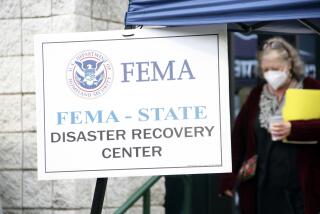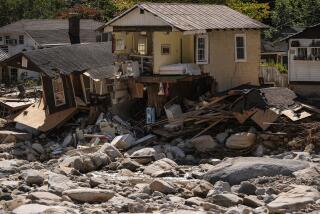Brownie points
MICHAEL BROWN WENT to Washington on Friday to throw more floodwater onto the Bush administration’s reputation, and he did a heck of a job. Brown’s testimony was more than just good political theater, however -- it was a guided tour of a dysfunctional federal bureaucracy.
As the former head of the Federal Emergency Management Agency, Brown played a central role in the administration’s tardy and ineffective response to the devastation wrought by Hurricane Katrina. He was reassigned and later resigned in disgrace, making him a convenient target last year during the first round of finger-pointing on Capitol Hill.
Facing a Senate committee for round two, Brown painted a picture of an unresponsive White House that did not grasp the gravity of the situation in New Orleans. Meanwhile, FEMA’s parent agency, the Department of Homeland Security, was too preoccupied with terrorism to be of much help on natural disasters, he said. He didn’t even bother to call his boss at the Department of Homeland Security, Secretary Michael Chertoff. The White House quickly responded to Brown’s testimony with a “setting the record straight” press release, arguing that the administration was well-prepared for the disaster and did everything it could.
Such inside-the-Beltway blame-a-thons are fun to watch, in a ghoulish sort of way. But this one also illuminated two obvious yet fundamental problems that threaten anyone dwelling in particularly risky environs -- on a fault line, for example.
First, it’s hard to coordinate all the federal, state and local agencies involved in responding to a catastrophe. Katrina blew out virtually every communications system in southern Louisiana, making it extraordinarily difficult for officials at various levels of government to see what was happening and coordinate a response.
Chertoff didn’t help matters by waiting until Aug. 30, 36 hours into the hurricane, to declare it an “incident of national significance,” setting the stage for a more coordinated federal response. And even then he did not label it a “catastrophic” incident, which would have triggered the most aggressive federal action, according to the Government Accountability Office.
Second, disaster plans are worthless if they’re not implemented. The situation in New Orleans was particularly bad because so many people had not evacuated despite the warnings from many public officials, including President Bush himself. Local leaders should have known that would happen -- extensive disaster simulations in 2002 and 2004 had predicted as much. Nevertheless, they did not have a system ready to evacuate residents who could not or would not leave voluntarily.
Even if the city had such a procedure in place, chances are good that it would have needed help from the federal government sooner and more forcefully than the administration delivered in September. That’s why communities across the country need to work with state and federal governments to define just how much they can and must do in the event of a catastrophe like Hurricane Katrina, as well as what precisely it will take for the feds to send in the cavalry.
More to Read
Sign up for Essential California
The most important California stories and recommendations in your inbox every morning.
You may occasionally receive promotional content from the Los Angeles Times.










